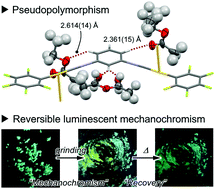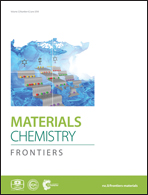A meta-diisocyanide benzene-based aryl gold isocyanide complex exhibiting multiple solid-state molecular arrangements and luminescent mechanochromism†
Abstract
Functional organic solids with switchable photoluminescence properties in response to external stimulation have attracted much interest because of their potential applications in sensors and imaging devices. Among these organic solids, luminescent mechanochromic compounds are emerging materials that can switch their photoluminescence properties when mechanically perturbed. Our group has intensively studied the solid-state emission properties and luminescent mechanochromism of a series of aryl gold isocyanide complexes. Here, we prepared bent-shaped binuclear gold isocyanide complex 2, which exhibits different pseudopolymorphs with different emission properties when prepared using different crystallization procedures. X-ray diffraction measurements and NMR spectroscopy indentified inclusion of solvent molecules in the crystalline lattices of 2 except for one polymorph. Complex 2 also shows luminescent mechanochromism based on a crystalline-to-amorphous phase transition. The ground phases of all of the pseudopolymorphs revert to the polymorph without solvent molecules upon thermal treatment.

- This article is part of the themed collection: Pi conjugated system bricolage (figuration) toward functional organic molecular systems


 Please wait while we load your content...
Please wait while we load your content...